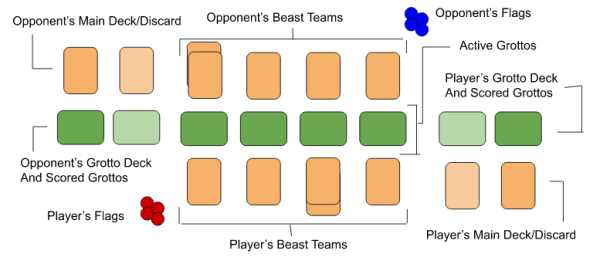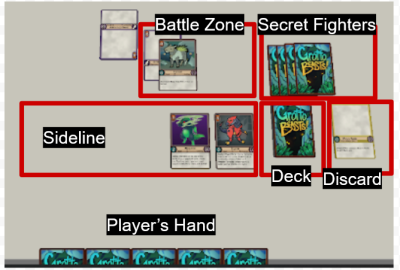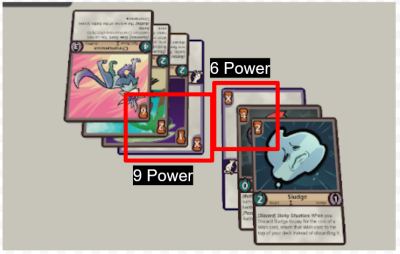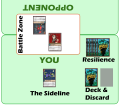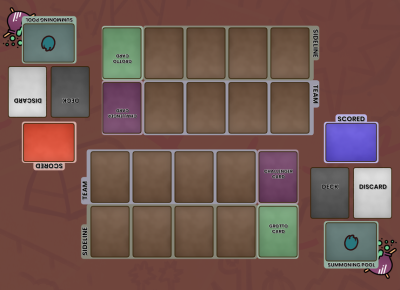Game Design Gallery: Difference between revisions
No edit summary |
No edit summary |
||
| Line 156: | Line 156: | ||
==Game Development== | ==Game Development== | ||
==Grottos, Team and Sideline=== | ===Grottos, Team and Sideline=== | ||
[[File:GBBetaLayout03.PNG|thumb|400px|Playtest version of the table mat.]] | |||
The first major changed that occurred was due to an interest in adding more structure to the game. Rather than have a random set of Beasts over the table, some playtesting went into setting a very specific set of places where Beasts would be summoned to. | The first major changed that occurred was due to an interest in adding more structure to the game. Rather than have a random set of Beasts over the table, some playtesting went into setting a very specific set of places where Beasts would be summoned to. | ||
| Line 197: | Line 198: | ||
==Retrospective== | ==Retrospective== | ||
The game was considered done almost the same time it was sent to the printers. There were rule book changes up to the last minute based on other feedback and periodic changes due to new designs coming to mind. The mad rush of getting everything to print left many last minute cards with little playtesting and the entire project littered with spelling mistakes and errors. There were so many problems we faced to try and make things right. And yet we still stand here making a project we didn't think we could. | The game was considered done almost the same time it was sent to the printers. There were rule book changes up to the last minute based on other feedback and periodic changes due to new designs coming to mind. The mad rush of getting everything to print left many last minute cards with little playtesting and the entire project littered with spelling mistakes and errors. There were so many problems we faced to try and make things right. And yet we still stand here making a project we didn't think we could. | ||
Latest revision as of 00:10, 28 November 2023
From initial concept to the final print, the game of Grotto Beasts went though many variations and changes to reach the game where it is today. Throughout that process, ideas and concepts from multiple sources were used as inspiration. This page documents the majority of the game design process as is able to share for those interested.
On March 11th, 2021, Community Jake called his board game designer friend J. Evan Raitt to discuss the possibility and practicality of creating a card game based off a 10 minute gag. Evan agreed, then did an internet search for this person named Jerma985 and Evan's algorithms have never been the same since.
Project Requirements
The core requirements of the project were made through a series of meetings held by Jerma985, Hollulu, Community Jake, and Evan, along with invited guests ster and Etalyx. There were many requirements made by Jerma while other requirements were set by Jake based on what was feasible by the team. Evan also provided his own design goals for the game, to allow him to flex his game design muscles. Over the course of development, many of the requirements were either dropped or made less important while others were put forward later in the game.
- A Trading Card Game for friends to hang out and enjoy
- The most important requirement from Jerma is that the card game was meant to provide a fun and enjoyable experience for players who just want to play a trading card game.
- It must be a trading card game with booster packs
- In order to fit the vision of the product, it must be obtainable though booster packs. While this might have been a given, it was important to state as otherwise I might have reinvented how trading card games worked.
- It must be easy to play. It should not be only for "hardcore" game players.
- The vast majority of players would all be casual, or not even play the game at all. Therefore, the game should cater to the widest net possible.
- The game should have rarities, holographic cards, and unique experiences.
- Other details the game may or may not have
- The game should include Jerma references in some way.
- The game should have as many cards as possible.
- The game does not have to match the prop version of the cards.
- The game should have a solo mode.
Initial Concepts
Starting Ideas
There were many variations of starting ideas that both Evan and Etalyx bounced off each other, using the concepts of various other games both had enjoyed to inform the design of the game.
| From: Game Design Notes |
|---|
| The concept for this game was built from researching out-of-print trading card games from the late 1990’s to mid 2000’s such as Chaotic, Hecatomb, Digimon Battle Arena, and the original printings of NetRunner and the Horus Heresy Card Game. The idea was to build a light-weight but strategic trading card game that utilized mechanics inspired by these defunct games to elicit nostalgia for a product that hadn’t existed before. Additionally, all alterations to the template were made under the pretense that Grotto Beasts had existed in 1997 and it’s being re-released with updated gameplay, artwork and features. Every change to the template has lore to logically explain the required updates. |
Story Draft
With the overall plot and feel of the game set, a story was put together to explain what Grotto Beasts even was. Many of the pitches for the game were based on these initial story beats for the theroretical TV show, and were later adopted, dropped, or expanded on based on where the rest of the team drew their own inspirations.
| From: Game Design Notes |
|---|
| Grotto Beasts Theme and Story:
Grotto Beasts is a lost franchise vaguely remembered from the late 1990’s. It had a terrible TV show that didn’t air most of the first season and the trading cards became worthless. After discovering booster packs of Grotto Beasts in a chest his grandfather had buried in the Nevada desert, the Twitch Streamer Jerma985 purchased the rights to the franchise. After reviewing the many files and details that he now had access to, Jerma decided to bring Grotto Beasts to the public in a way that it originally should have been, so hired some people and told them to get to work. General Plot - Grotto Beasts believe in the power of friendship and working together as a team to defeat the opponents that challenge control over their homes, the grottos. To this end, the card game is designed around Beasts playing off each other as friends and working with each other to defeat enemies. Teams and Team Leaders - During battles, Grotto Beasts don’t just randomly jump into a fight - they work together in Teams, and the strongest among them is considered their Team Leader, like a pack. The Grottos - While the Grotto Beasts are known for being protective of their homes, the lands they find sacred are their Grottos, magical locations carved in the land. It is these locations that Grotto Beasts will fight to protect or obtain. Families and Nomads - Unlike Pokemon’s Types or Magic: The Gathering’s Colors, Grotto Beasts come from many different and unique Families, based off the real-world taxonomic ranking. When building a deck, a player will need to select one Family and utilize only the cards from it. There is also a special group of Beasts that do not have a Family, called Nomads. Like mercenaries, the Nomads will help whomever will take them in. Nomads in the card game can fit into any deck, regardless of the Family chosen. Wishes - Arguably one of the worst parts of the TV show was when the Human Characters would make Wishes. Every episode, these were nothing but a deus ex machina method of resolving the conflicts and getting to the end of each show. But as they were integral to the lore of the show, they are added to the card game as one-time effects. |
Game 1, The Positioning Game
The Positioning Game was the work in progress name for a game design that utilized many of the original aspects of the prop cards and was meant to change up a few ways in how trading card games work.
The general idea was for each player to summon a consecutive stack of Beasts within one of four lanes, which were headed by a Grotto. At a specific time, as determined by an active player, they would choose to initialize a battle on any one of the Grottos. The player's Team that held the most in the given Traits as shown by the Grotto would win the Grotto, and a new Grotto would replace it. The object of the game was to score seven Grottos, or have all of your Grotto Cards in your Grotto Deck be spent.
| From: Game Design Notes |
|---|
| Initial Concept, J. Evan Raitt, 3/15/2021
Generally speaking, the game revolves around players Summoning Beasts to attempt to Claim and eventually Capture the Grottos in front of them. Players may bolster their Beasts through the use of “Friendship and Teamwork”, by Summoning Beasts on top of those previously Summoned, forming a team that shares their Stats to the Team Leader so it’s stronger than it would be if they were Summoned alone. Players may use Wishes to gain one-time abilities or bonuses throughout the game. This eventually culminates in a Battle which can alter the ownership of Grottos and end in Captures. The first player who is able to Capture any 7 Grottos is the winner of the game. The Main Deck - The Main Deck must contain exactly 30 cards containing Beast and Wish cards, based on the following deck construction Rules: - When constructing a deck, the player must declare one Phylum. The player is then able to construct their deck using Beast and Wish cards from that Phylum and Beast and Wish cards from the Nomads. - A player may add up to 3 of cards with the exact same name to the main deck. - Beasts and Wishes from other Phylums may be added based on Partner Points. Players have a maximum of 9 Partner Points to spend on individual cards. However, Bosses may only be included in decks of the chosen Phylum as they do not have a Partner Point cost. The Grotto Deck - This secondary deck must contain exactly 7 cards containing only Grotto cards, based on the following deck construction Rules: - Players may include any number of the same Normal Grotto card to their Grotto Deck. - Special Grotto cards may only have a maximum of 1 card per Grotto Deck. ... ... ... Team Building Step - Players may Summon Beasts and make Wishes during this Step. - Each Grotto Card forms a Lane on both sides of the card, allowing for Beast Cards to be Summoned into the Lane and forming a Team. A player is allowed to Summon up to one Beast per lane on their side of the Grotto during this step, and may use as many Wishes as the player would like. - In order to Summon a Beast to a Team, the player must discard a number of cards equal to the Friendship Level on the Beast Card they are Summoning. Once a Beast is summoned, it remains face up in the lane, and the face up Beast is named the Team Leader. - Players may Summon a new Beast in a Team on top of the previous Beast in the lane, which will become the new Team Leader. The Friendship Cost of discarding cards to Summon the Beast Card is reduced by the Friendship Level of the current Team Leader. (e.g. There is a Beast with Friendship Level 3 in a team and the player wants to Summon a beast with a Level of 7. Rather than discarding 7 cards, they discard 7-3, which is 4 cards). The newly Summoned Beast is placed on top of the previous one, being now the new Team Leader. It is recommended players place the card on top of the previous one that the Stats of the Beast on the bottom is visible. The Stat’s total Power for the Team Leader is equal to the stats printed on their card and the stats of all Beasts underneath them in the Team, giving them more Power to their stats. - While teamwork is important, Beasts don’t like it when a weaker Beast becomes the Team Leader. In order to Summon a new Beast to a Team, that Beast must have a Friendship Level greater than the level of the current beast in the Team. (e.g., a Beast with Friendship Level 3 may not be Summoned and placed on top of a Beast with Friendship Level 7.) |
Among the most interesting part of the design in this game is the concept of Team Building. The idea is that how you build up Beasts under a Grotto is important, and the key to winning the Grotto. Many of the aspects of the final game, including how things are named, come from this very specific version of the game that no longer matches the final version.
Game 2, The Combat Game
The Combat Game was a pure competitive game that worked like a mixture of both the casino game Blackjack, and a single lane of The Positioning Game. Players would build a deck of Fighters, also known as Leaders (and later name named Challengers) that made up a Leader Deck. The Leader Deck had a few building restrictions, but otherwise worked like the Grotto Deck from Game 1.
Each player would put one random Leader from their Leader Deck onto the Combat Zone, and then take turns summoning additional Beast Cards to their Leader and build a chain of Teamwork. The total Power of a Team once both players passed the turn would determine the winner. The Leader of the losing team would be discarded and they must pull a new Leader. The first player to knock out all of their opponent's leaders was the winner.
This was also the introduction of the Sideline, a separate area were players could summon Beasts to use for later, or for passive effects.
| From: Game Design Notes |
|---|
|
Round Order: Rather than specific Turn Order, the game of Grotto Beasts is played in Rounds. During a Round, players perform specific things during specific times. Draw Phase During the Draw Phase, players draw cards from the top of their Deck until they have reached 5 cards in their hand. A player already with 5 or more cards in their hand is unable to draw further. Turn Phase Starting with the player with the Fighter with the least Power, players take turns performing actions with their cards in hand or already played from previous Rounds/Turns. To Summon a card from a player’s hand, they must discard a number of other cards from their hand equal to the Summoning Cost as listed on the card. Beasts and Grottos may be summoned either directly to the Battle Zone or to their Sideline. Wishes are typically one-time effects, that after they are used are discarded - however some Wishes are Battle Effects which will remain in the Battle Zone until the Battle has concluded. Grottos may also be added to the Battle Zone, however only one Grotto may be in the Zone at a time. If a Grotto is already in the Zone, the previous one is discarded for the new one to take its place. A player’s Turn within the Round is over either when the player Summons or plays any type of card into the Battle Zone, or if the player chooses to Pass. After either event, the next player takes their turn and does the same. This process continues, with players cycling turns being the active player as they summon cards to the Battle Zone. Once a player would be given a Turn, but had chosen to Pass, the Turn Phase ends and the game moves to the Battle Phase. Battle Phase The Battle Phase is specifically the part of the game where players calculate the total Power their Team of Beasts with their Fighter has. Whichever player has the highest total power is declared the Winner of the Battle. In the event of a tie, the Battle is simply a Tie. There must always be a Battle Phase, unless otherwise noted. Winning the Game This Variant is about defeating all of your opponent’s Fighters. The first player to knock out each of their opponent’s 5 Fighters before their own is all knocked out, is the winner. |
The Pitch to Jerma
The main pitch to Jerma, Hollulu and Community Jake shared both Games 1 and 2, with 3 other minor games that had edits to the core concept of those options. There were at least three versions of the pitch: An initial pitch to show that I could do the job, a secondary pitch of Games 1 and 2, with two other variations of each, and a third pitch that followed to explain the Combined Version of the game.
Throughout the pitches, the Grotto Beasts team was given a show of the many variations that were designed for the game, and some other variations and options. Jerma and Hollulu provided feedback based on the concepts they liked and which they felt were required to avoid, including some re-discussion of the goals of the project and limits of the product.
It was determined that in the end that Game 2 would be the direction the game would move but it was expected that the game would continue to evolve as the rest of development continued.
Game Development
Grottos, Team and Sideline
The first major changed that occurred was due to an interest in adding more structure to the game. Rather than have a random set of Beasts over the table, some playtesting went into setting a very specific set of places where Beasts would be summoned to.
The first of these changes pushed Beasts to 4 Team Slots and 4 Sideline Slots. A 5th Slot on the Team became reserved for the rotating set of Challengers (previously named Leaders or Fighters) would be dedicated to, and a 5th slot was dedicated to the player's single Grotto that would provide passive effects throughout the game. This new change was a hit with playtesters as it felt more like a card game and it was much easier to understand what was going on. A number of cards began to fit into their places, reaching a point where the game started to feel real.
During card development, I was getting very frustrated with coming up with so many Grottos that would only perform one purpose in the game. One of the first ways I set to mitigate this was to bring an idea of 'rotating' Grotto cards, where the point of them was to switch them about during the game though summoning and bonuses would be applied for each time a Grotto enters play and leaves play. This proved to be annoying and still not provide enough varied mechanics to fill out the number of Grotto spots.
In a simple moment of "Oh What the hell", I instructed Hollulu during a playtest that we should try playing as many Grotto cards as we want on our Sidelines. It was an INSTANT hit from the first turn, and the possibilities for Grottos vastly increased. From that point on the dedicated Grotto spot was removed and to maintain symmetry, the dedicated Challenger spot was also removed. This lead to the ideas and concepts of using the spaces of the Team and Sideline to allow for positioning abilities - effects that give benefits for being above or below and side to side. This was not only built in to help distinguish itself from other games with similar table-space structures, but increase the mechanics that could be used.
Challengers, Battle, and Scoring
After the massive success of the rework of the Team and Sideline, more work into developing a better combat system. Since now there were a limited number of Beasts and Challengers that were in play at a time, making the combat more expressive to that concept was needed. However, the core concept of "All beasts attacking as one" was still desired from a creativity standpoint.
At this time, the Resilience was this weird mechanic of health for a character, that decreased over time, but having to spend so many cards for such an ability was weird. Continuing to make simple changes, the mechanic was reversed - instead of being a health players needed to deplete, the object was to collect the number of cards. This changed Resilience to Goal and was another fundamental change that helped the game along.
The Summoning Pool
Much of the game was well crafted at this point, but there was a huge issue with the game - it was slow and not fun. The game's energy and hype slowed to a crawl and nearly stopped. I cannot begin to express how dark this time was for the game's development. It's important to understand why - in order to summon a card, you discarded the cards from your hand to pay the cost and they never came back. It was horrible, but oddly enough no one on the team had any idea why that mechanic was so bad and why it was so detrimental. In hindsight it's laughable to think that problem was so hidden - but with the weight of the community on one's shoulders, it was.
As the team went into a minor hibernation to focus on other Jerma985 projects, there was an effort to determine the root cause of the issues and determine how to solve them. Through countless playtesting and discussions with fellow game designers, there were a few points that could have been the cause of the issue but no attempted changes fundamentally fixed the underlying problems.
During one sleepless night at nearly 3:00AM, I decided to try a different approach - I went back to brainstorming and research. The idea was to look at the problem at a different angle. Rather than trying to fix what was broken, learn from already established games and learn what could be missing from Grotto Beasts. During this dive to researching cards, I stumbled on many YouTube videos of people playing games to gain insight. Nothing was clicking until I discovered the YouTube Channel [CardProtagonist]. The extremely distinct format of their videos taught me one thing - Grotto Beasts is not just slow, it is completely missing a flow. I desperately desired to update Grotto Beasts to play in the same type of way that CardProtagonist plays their games.
Over that night, I kept the way players summoned - but rather than have a Discard Pile at all, the discard pile would be a pool of cards that you get back every turn. After you end your turn, you draw your entire discard pile back to your hand. This would refuel your hand with cards to summon with and was the breakthrough I needed. Obviously that wasn't going to work, but it planted the seed to continue to look at other ways to develop that same kind of system. I would come up with something, act it out with a deck of playing cards, and if I couldn't imagine CardProtagonist doing it either it was dropped and reworked.
I finally settled on inventing a whole other pile of cards, that would ebb and flow as players summoned cards. It finally hit the mark that I wanted, and over time the Summoning Pool as currently designed was made.
It's difficult to express how game changing it was. From that point, the game became near finalized and only required the remaining cards to be built.
Retrospective
The game was considered done almost the same time it was sent to the printers. There were rule book changes up to the last minute based on other feedback and periodic changes due to new designs coming to mind. The mad rush of getting everything to print left many last minute cards with little playtesting and the entire project littered with spelling mistakes and errors. There were so many problems we faced to try and make things right. And yet we still stand here making a project we didn't think we could.
I am not going to tell you that Grotto Beasts is my most successful project. It still has a long ways to go to be the perfect version it can be. But the experiences of designing this game will forever be a dream for me. I cannot begin to express how important imagining the Summoning Pool was. I can't begin to show how amazing it was to see all the "ah ha" moments for playtesters. I cannot being to share how impactful it is to see YouTube recommending Grotto Beasts content to me.
I joined the project not knowing who Jerma is and what the word byeah even means. But I've come to meet so many awesome people in the community and work with very passionate artists and creatives. It's been amazing, and I owe the success the project has to the entire community.
Time to make more cards!
Thank you, -J. Evan Raitt
